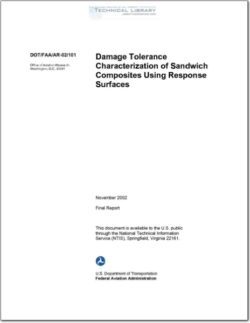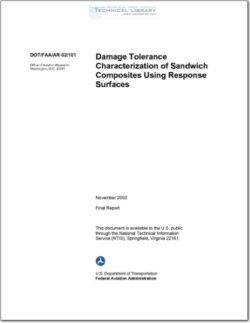DOT-FAA-AR-02-101

- Version
- 238 Downloads
- 2.17 MB File Size
- 1 File Count
- March 24, 2016 Create Date
- March 24, 2016 Last Updated
Damage Tolerance Charcterization of Sandwich Composites Using Response Surfaces

The influence of material configuration and impact parameters on the damage tolerance
characteristics of sandwich composites comprised of carbon—epoxy woven fabric facesheets and
Nomex honeycomb cores was investigated using empirically based response surfaces. A series
of carefully selected tests were used to isolate the coupled influence of various combinations of
the number of facesheet plies, core density, core thickness, impact energy, impactor diameter,
and impact velocity on the residual strength degradation due to normal impact. The ranges of
selected material parameters were typical of those found in common aircraft applications.
Quadratic response surface estimates of the compressive residual strength as a continuous
function of material system and impact parameters did not correlate as well as impact resistance
because of bifurcations between failure modes. For a fixed set of impact parameters, regression
results suggest that impact damage development and residual strength degradation is highly
sandwich configuration dependent. Increasing the number of facesheet plies and the thickness of
the core material resulted in the greatest improvement in the damage tolerance characteristics.
An increase in the impactor diameter and impact energy results in a significant decrease in the
estimated residual strength, particularly for those sandwich panels with thicker facesheets. The
effects of impact velocity on damage formation and loss of strength were also addressed. The
development response surfaces for the compressive residual strength may have limited use,
particularly as the measured data at low-energy impact levels, small impactor diameter, and thin
facesheets exhibit significant scatter. Employing the methodology outlined here, it may be
possible to tailor sandwich composite designs to obtain enhanced damage tolerance
characteristics over a range of expected impacts. Such efforts may facilitate sandwich panel
design by establishing relationships between sandwich configuration and impact parameters that
lead to improved damage tolerance and resistance.
Sandwich construction composites are used in a wide variety of structural applications largely
because of their relative advantages over other structural materials in terms of improved stability
and weight savings. Sandwich plates and shells are multilayered structures consisting of one or
more high-strength, stiff layers (e.g., laminated facings) that are bonded to one or more flexible
layers (core), as shown in figure 1. While the initial design of composite sandwich structures is
at a fairly mature stage of development [1-3], less progress has been made in understanding the
effect of adverse in-service impact events on the structural integrity of such structures. Such an
understanding is critical if there is to be widespread use of sandwich composites in applications
where structural durability and damage tolerance are primary considerations (e.g., aerospace or
automotive applications).
| File | Action |
|---|---|
| DOT-FAA-AR-02-101 Damage Tolerance Charcterization of Sandwich Composites Using Response Surfaces.pdf | Download |
Comment On This Post